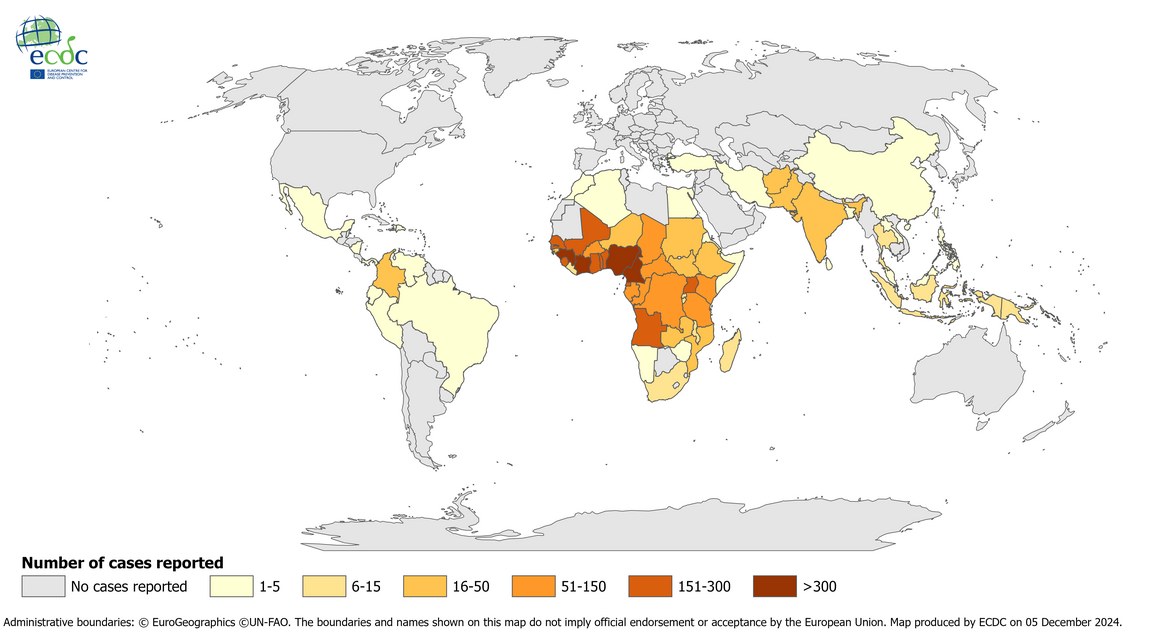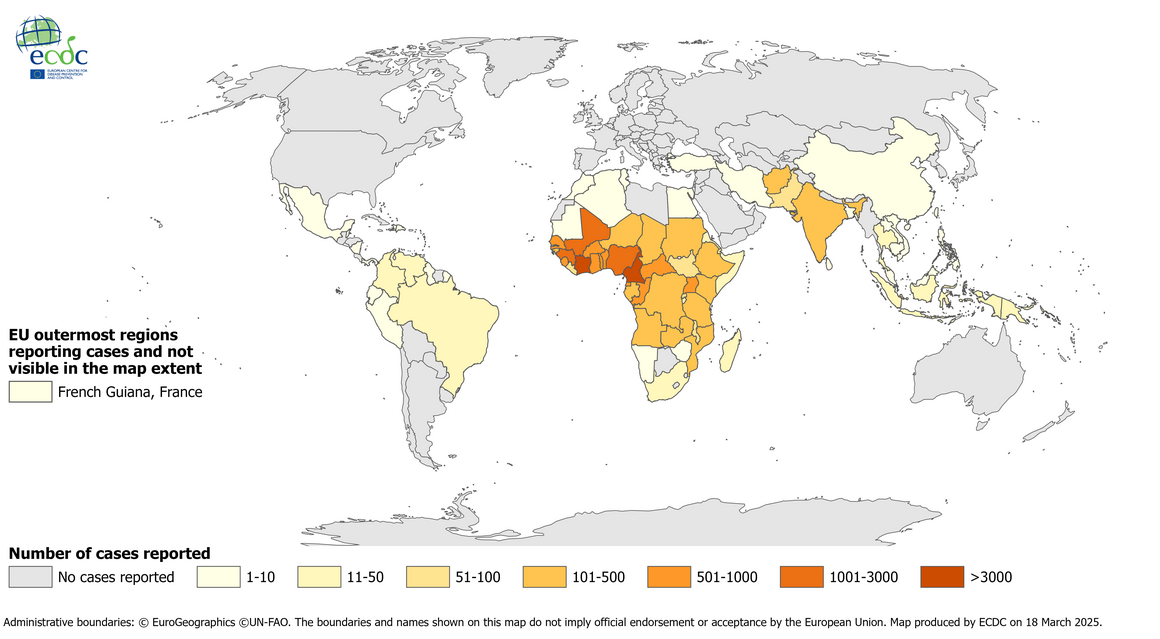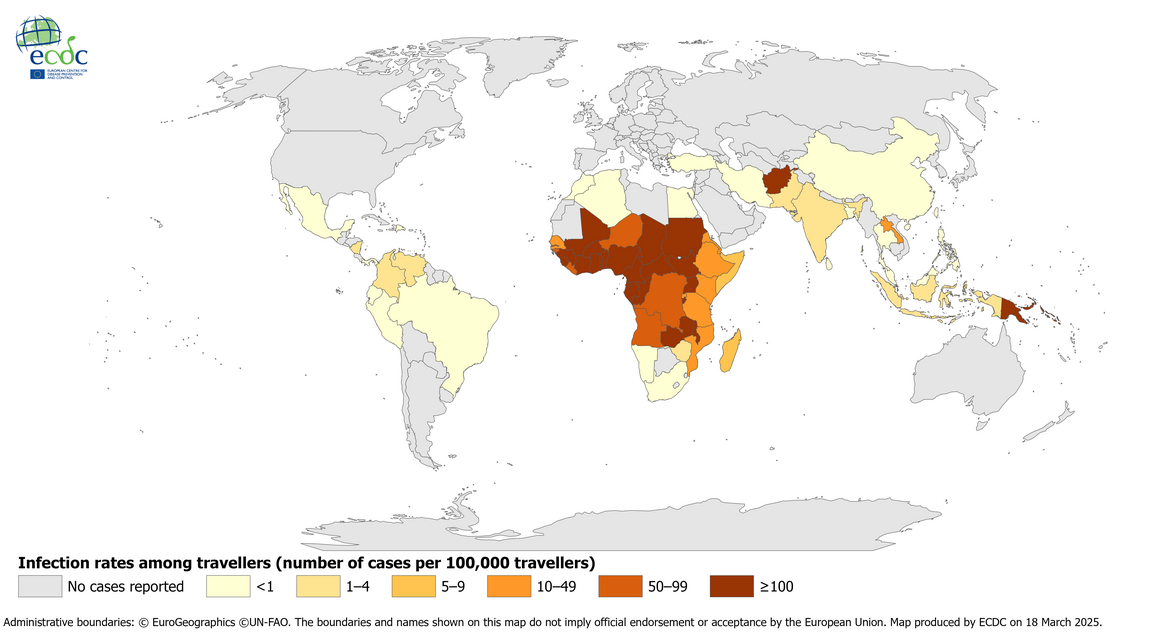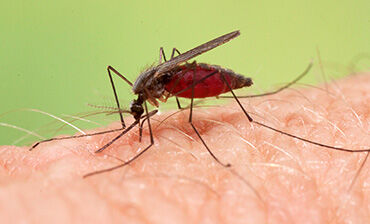Malaria contracted during travel: likely places of infection reported by travellers to the EU/EEA
The maps and table below depict the locations where people with travel-associated malaria cases contracted the infection, as reported to ECDC. These are presented as number of cases and infection rates per 100 000 travellers. The aim is to inform public health authorities and EU/EEA citizens about the risks associated with malaria.
Annual epidemiological reports
Travel-associated malaria cases reported to ECDC, by place of infection, 2023

Travel-associated malaria cases reported to ECDC, by place of infection, 2019–2023

Rates of malaria infection among 100 000 travellers arriving in the EU/EEA, per country of infection, 2023

Download the data
When importing data.csv in MS Excel, please do not forget to select Unicode (UTF-8) as encoding.
About the data
The report is based on confirmed malaria cases reported to ECDC by EU/EEA countries through the EpiPulse Cases platform, as of December 2024. It includes only people diagnosed in the EU/EEA that specify a single location of infection.
Data on the place of infection were provided at the sub-national level for the EU outermost regions*, while for other locations, the data were at the national level. People who contracted the infection in the EU outermost regions* were classified as travel-associated and were not included in the national count for France, Portugal or Spain. Both locally-acquired and travel-associated cases who contracted the infection within mainland EU/EEA were excluded.
In this summary, to remove outliers, we included places of infection linked to confirmed cases identified over the past five years if they met any of the following criteria:
- they were identified in at least two different years; or
- they were identified in at least two different EU/EEA countries; or
- at least five cases were associated with a single place of infection.
Infection rates among travellers were calculated using the aforementioned EpiPulse Cases data from 2023 and the International Air Transport Association data (IATA, MarketIS, 6 December 2024), which captures air passenger flows. MarketIS data records direct flights or connected flights from point A to point B with potential layover times of 18 hours or less. These data were further filtered to include any flight scheduled in 2023 departing from any country or EU outermost region worldwide and arriving in mainland EU/EEA.
Incidences among travellers were calculated as follows:

Confidence intervals were calculated using the Clopper-Pearson method.
The data presented in this summary should be interpreted with caution for the following reasons:
- the data were included as reported by EU/EEA countries and were not validated by the health authorities at the places of infection;
- this summary does not account for regional disparities within the places of infection, despite some areas where there is a higher risk of infection than others;
- the data presented only cover the years 2019−2023 and therefore do not imply ongoing transmission.
- in the analysis, only MarketIS flight data is used, which only includes direct flights and connected flights, and excludes other forms of international travel such as by bus, train, boat or car.
*EU outermost regions include Guadeloupe, French Guiana, Réunion, Martinique, Mayotte and Saint-Martin (France), the Azores and Madeira (Portugal), and the Canary Islands (Spain).

About malaria
Malaria is an infectious disease caused by a protozoa and spread by Anopheles mosquitoes. Malaria is widely distributed across tropical and sub-tropical regions. It is not endemic in mainland Europe and the vast majority of cases are travellers who contract the infection outside of mainland Europe. Malaria is a notifiable disease at the EU level and surveillance data are collected by ECDC through the EpiPulse Cases platform.




